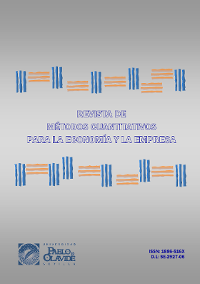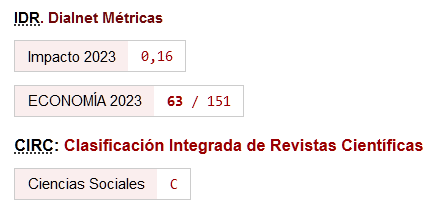Contrastes de raíces unitarias y cambios estructurales: un estudio con aplicaciones
DOI:
https://doi.org/10.46661/revmetodoscuanteconempresa.2065Palabras clave:
Unit root, structural breaks, multiple breaks, raíces unitarias, cambios estructurales, cambios múltiplesResumen
El tema de las raíces unitarias en series temporales macroeconómicas ha recibido gran atención, tanto desde el punto de vista teórico como de investigación aplicada, en las últimas tres décadas. Desde el trabajo clave de Nelson y Plosser (1982), contrastar la presencia de una raíz en datos temporales ha llegado a ser un asunto de gran interés. Esta cuestión ganó incluso preponderancia con el artículo de Perron de 1989, que destaca la importancia de los cambios estructurales al contrastar procesos de raíces unitarias.
Este trabajo revisa la literatura disponible sobre contrastes de raíces unitarias, teniendo en cuenta los posibles cambios estructurales. Se explica la diferencia entre contrastar cambios cuando la fecha del cambio es conocida (o exógena) y cuando el cambio es determinado endógenamente. También describimos contrastes tanto para cambios simples como para cambios múltiples. Además, el artículo revisa los estudios empíricos y da una aplicación para que los lectores puedan comprender los problemas subyacentes que se están afrontando en el estudio de las series temporales con cambios estructurales.
Descargas
Citas
Amsler, C and Lee, J. (1995), “An LM test for unit root in the presence of a structural change”, Econometric Theory, 11, pp. 359-368.
Banerjee, A., Lumsdaine, R. L., and Stock, J.H. (1992), “Recursive and Sequential Tests of the Unit Root and Trend-Break Hypothesis: Theory and International Evidence”, Journal of Business and Economic Statistics, 10, pp. 271-287.
Ben-David, D and Papell, D.H. (1995), “The Great Wars, the Great Crash and the Unit Root Hypothesis”, Journal of Monetary Economics, Vol. 36, pp. 453-475.
Ben-David, D., Lumsdaine, R., and Papell, D.H. (2003), “Unit Root, Postwar Slowdowns and Long-Run Growth: Evidence from Two Structural Breaks”, Empirical Economics, 28(2), pp. 303-319.
Christiano, L.J. (1992), “Searching for a Break in GNP”, Journal of Business and Economic Statistics, 10, pp. 237-249.
Clemente, J., Montañés, A., and Reyes, M. (1998), “Testing for a unit root in variables with a double change in the mean”, Economics Letters, Vol. 59, pp.175-182.
Dickey, D.A and Fuller, W. A. (1979), “Distributions of the Estimators for Autoregressive Time Series with a Unit Root”, Journal of American Statistical Association, 74(366), pp.427-481.
Dickey, D.A and Fuller, W.A. (1981), “Likelihood Ratio Statistics for Autoregressive Time Series with a Unit Root”, Econometrica, 49(4), pp.1057-1072.
Gregory, A. W and Hansen, B. E. (1996) “Tests for cointegration in models with regime and trend shifts”, Oxford Bulletin of Economics and Statistics, Vol. 58, pp. 555-560.
Ghatak, A. (1997), “Unit roots and structural breaks: The case of India 1900-1988”, Journal of Applied Statistics, 24:3, pp. 289-300.
Lee, J. and Strazicich, M.C. (2003), “Minimum LM Unit Root Test with Two Structural Breaks”, Review of Economics and Statistics, 63, pp. 1082-1089.
Lee, J. and Strazicich, M.C. (2004), “Minimum LM Unit Root Test with One Structural Break”, Working Paper, Department of Economics, Appalachain State University.
Lumsdaine, R. L and. Papell, D. H. (1997), “Multiple Trend Breaks and the Unit Root Hypothesis”, Review of Economics and Statistics, 79 (2), pp. 212-218.
Maddala, G.S. and Kim, I.M. (2003), Unit Root, Cointegration and Structural Change, Cambridge University Press, Fifth Edition, UK.
Nelson, C.R. and Plosser C.I. (1982), “Trends and random walks In Macroeconomic Time Series”, Journal of Monterey Economics, 10, pp.139-162.
Nunes, L., Newbold, P. and Kuan, C. (1997), “Testing for Unit Roots with Breaks: Evidence on the Great Crash and the Unit Root Hypothesis Reconsidered”, Oxford Bulletin of Economics and Statistics, 59, pp.435-448.
Ohara, H.I. (1999), “A unit root test with multiple trend breaks: A theory and application to US and Japanese macroeconomic time series”, The Japanese Economic Review, Vol. 50, pp. 266-290.
Pappel, D.H. and Prodan, R. (2003), “The uncertain unit root in US real GDP: Evidence with restricted and unrestricted structural change”, Journal of Money Credit and Banking, Vol. 36, pp. 423-427.
Perron, P. (1989), “The great crash, the oil price shock, and the unit root hypothesis”, Econometrica, 57, pp.1361-1401.
Perron, P. (1994), “Trend, Unit Root Hypothesis and Structural Change in Macroeconomic Time Series”, in Roa, B.Bhasakara, ed., Cointegration for Applied Economists, St. Martin’s Press.
Perron, P. (1997), “Further Evidence on Breaking Trend Functions in Macroeconomic Variables, Journal of Econometrics, 80(2), pp.355-385.
Perron, P. (2005), “Dealing with Structural Breaks”, Mimeo forthcoming in the Vol. 1 Handbook of Econometrics: Econometric Theory.
Perron, P. and Vogelsang, T. J. (1992), “Nonstationarity and Level Shifts with an Application to Purchasing Power Parity”, Journal of Business and
Economic Statistics, 10, pp. 301–320.
Phillips, P. and Perron, P. (1988), “Testing for a Unit Root in Time Series Regression”, Biometrica 75(2), pp. 335-346.
Raj, B. (1992), “International evidence on persistence in output in the presence of an episodic change”, Journal of Applied Econometrics, 7, pp. 281-293.
Saikkonen, P. and Lütkepohl, H. (2000) “Testing for the cointegrating rank of a VAR process with structural shifts”. Journal of Business and Economic Statistics, Vol. 18, pp. 451-464.
Stulz, R.M. and Wasserfallen, W. (1985),”Macroeconomic Time Series, Business Cycles and Macroeconomic Policies,” Carnegie-Rochester Conference Series on Public Policy, 22, pp. 9-54.
Strazicich, M.C., Lee J. and Day, E. (2004), “Are countries converging among OECD countries? Time series evidence with two structural breaks”, Journal of Macroeconomics”, 26, pp. 131-145.
Wasserfallen, W. (1986), “Non-stationarities in macro-economic time series - further evidence and implications”, Canadian Journal of Economics, 19, pp. 498- 510.
Zivot, E. and Andrews, K. (1992), “Further Evidence On The Great Crash, The Oil Price Shock, and The Unit Root Hypothesis”, Journal of Business and Economic Statistics, 10 (10), pp. 251–70.
Descargas
Publicado
Cómo citar
Número
Sección
Licencia
Derechos de autor 2007 Revista de Métodos Cuantitativos para la Economía y la Empresa

Esta obra está bajo una licencia internacional Creative Commons Atribución-CompartirIgual 4.0.
El envío de un manuscrito a la Revista supone que el trabajo no ha sido publicado anteriormente (excepto en la forma de un abstract o como parte de una tesis), que no está bajo consideración para su publicación en ninguna otra revista o editorial y que, en caso de aceptación, los autores están conforme con la transferencia automática del copyright a la Revista para su publicación y difusión. Los autores retendrán los derechos de autor para usar y compartir su artículo con un uso personal, institucional o con fines docentes; igualmente retiene los derechos de patente, de marca registrada (en caso de que sean aplicables) o derechos morales de autor (incluyendo los datos de investigación).
Los artículos publicados en la Revista están sujetos a la licencia Creative Commons CC-BY-SA de tipo Reconocimiento-CompartirIgual. Se permite el uso comercial de la obra, reconociendo su autoría, y de las posibles obras derivadas, la distribución de las cuales se debe hacer con una licencia igual a la que regula la obra original.
Hasta el volumen 21 se ha estado empleando la versión de licencia CC-BY-SA 3.0 ES y se ha comenzado a usar la versión CC-BY-SA 4.0 desde el volumen 22.










